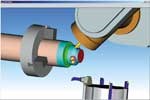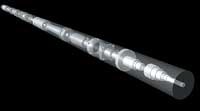Boost Throughput With Multitasking
As a shop’s typical workload moves beyond high-production turned parts, new ways to reduce leadtimes and improve machining accuracy are evolving.
For a shop that is looking for alternative opportunities to grow its business, multitasking machines present an option to open additional markets that go beyond the typical screw machine niche. This technology can bring a shop into low- and medium-volume and prototyping work that otherwise may not have been practical. These jobs often call for a little extra: Maybe tighter tolerances are required or perhaps delivery times are shorter. Multitasking, with B-axis capabilities, can bring the necessary solutions for cycle time reduction with faster throughput, lower operating costs and increased part accuracy.
Multitasking can take a variety of forms, but typically the concept incorporates all machining processes, from raw material input through final machining, in one machine. It provides the ability to reduce production leadtime, improve machining accuracy, reduce floor space and initial cost, lower operating expenses, reduce operator requirements and improve the work environment.
Then And Now
Originally, the multitasking concept was defined as the capability of performing turning and milling on the same machine. Over time, the idea migrated to milling with a secondary spindle to do light machining on secondary operations, but rotary tools were generally underpowered and axis travel rates were slow compared to a stand-alone machining center. Eventually, machines with full second-spindle capabilities became the trend. These machines included toolchangers, a Y axis for off-center work and a B axis for angle milling and drilling. Multitasking machines have not been limited to lathes, but also include both horizontals and verticals with multi-face machine capability and automated pallet delivery systems.
Today, multitasking is generally considered the ability to perform various manufacturing operations without manual intervention. A single toolholder is used in place of the tool turret, allowing turning, milling, drilling, tapping, facing, grooving and threading operations in one setup. The toolholder is serviced by an automatic toolchanger located outside the cutting zone, with capacity sometimes ranging as high as 330 tools on larger machines. Transfer from the first to second machining operation is untended, with auto load/unload during machining operations.
One example of a machine designed for multitasking work is the Integrex 100-IV, from Mazak Corp. Each machine in the Integrex series brings together a high-powered turning center with a full-function machining center to produce parts in a single setup. The high-speed milling spindle that can tilt as much as 240 degrees, the optional lower turret with rotary tool spindle and the second spindle with the same C-axis functions as the main spindle all contribute to the machine’s flexibility. The B and C axes allow minimum-increment indexing of 0.0001 degree.
As with other machines designed for multitasking work, the Integrex line is designed to reduce manufacturing costs by drastically cutting handling and setup time, reducing the number of fixtures and tools and shortening waiting time. A single machine allows a shop to be competitive on round parts with secondary operations, fully prismatic parts from solid or castings or sculptured parts such as aerospace components and molds.
The milling capabilities on machines such as the Integrex are now equal to many stand-alone machining centers. These machines are achieving the overall goal of multitasking, which is to compress the manufacturing cycle by keeping the spindles running and doing multiple operations per loading.
Faster cycle times are not the sole route to multitasking success. Fast cycle times, while increasing speeds in a certain part of the operation, can create bottlenecks in the overall process. The process can be compared to putting a high-speed rail car on a train full of standard box cars. The high-speed car can’t go any faster than the entire train. The goal with multitasking is to create a faster “train” by increasing throughput. And the key to increasing throughput is to reduce the amount of movement that a part must make. No value is added to a part when it is moving.
Multitasking and the faster throughput that it provides have a direct affect on reducing operating costs. The single-setup cutting capability of turn-mill machines today does not sacrifice performance relative to sequentially used stand-alone turning centers and machining centers. Turn-mill machines with gantry loaders or other automatic material handling units often exceed the productivity of machining centers and turning centers in cellular arrangements. And because more operations are being produced by one machine, less floor space and fewer operators are needed. Requirements for workholding and fixturing and setups are also reduced, along with power consumption. Because parts are produced faster, inventory can be kept to a minimum.
Multitasking To Lean
Every shop wants lean manufacturing, but what needs to be accomplished to get there? Ever since Henry Ford developed the first high-volume assembly line (transfer line), others have been looking for ways to improve the idea. But even today, the idea of transfer line assembly—doing some work on a part and then passing it on to the next station—remains prevalent.
Recent developments have forced a process reevaluation on the manufacturing floor. Lower order quantities, just-in-time delivery requirements, shorter product life cycles and the effects of global competition have brought new demands for flexibility.
So where does this flexibility come into play with multitasking machine tools? Consider a job that requires several operations to complete. This might include a range of turning operations, vertical machining center operations and horizontal machining operations. Even with setup times and cycle times well balanced, moving the part from one station to the next takes valuable time. Then, the further into the process a part gets, the more important accurate setup becomes to ensure that the previous operations were not wasted. Another key factor to consider is scheduling time on the machines, not only once, but for each operation. Often, the work queue of a busy shop can force a job to wait for hours or even days at each station. The result could be a delay of weeks before the job can actually be shipped.
Reducing total in-process time while increasing accuracy of the parts is where multitasking machines strongly relate to lean manufacturing. The basic idea of lean manufacturing is to eliminate waste, whether it’s motion (machines in a cell or designed to allow installation close together), work-in-process (less time in the shop between raw material and shippable product) or non-value-added tasks (anything that keeps the machine from running, such as setup time, time between jobs, operator paperwork, trips to the crib, retrieving the next job). The multitasking machine addresses these issues.
As with any lean manufacturing production schedule, a work queue is inevitable. With multitasking machines however, completed work orders will not wind up five machines away. Instead, they are done in one machine.
An Accurate Picture
Multiple machines, departmental transitions, shift changes and different operators can each affect the overall accuracy of an operation, particularly when it involves multiple setups. Shop managers often ask themselves during which shifts to run the high-accuracy parts or which operator should get a particular job. Each person does things differently, affecting the outcome of production. However, multitasking machines, because of their tool matrix and ease of moving from job to job, take some of the guesswork out of making consistently accurate parts.
When moving a part from station to station or work cell to work cell, starting points need to be continually redefined. Future accuracy is dependent on the accuracy of the previous operations. However, without the need to move a part from machine to machine, tolerance stack-up is avoided.
Multitasking machines allow better spindle use, more predictable throughput, quicker setups and more accurate parts. If setup time is measured from the last good part of the current job to the first good part on the next job, then multitasking machines may just be the best solution.
One argument might be that a single machine can’t show optimal performance for two different operations. Although, the efficiency gained through less workpiece handling, the higher tolerances and faster throughput make the technology worth considering. It is not suitable for all applications, but in the right situations, the value can be substantial.
Read Next
Mill/Turn Centers Spur Shop's Growth With Increased Uptime
After adding a 12,000-square-foot addition onto an existing 32,000-square-foot facility, the management of Nolte Precise Manufacturing (Cincinnati, Ohio) is in the mindset to expand its business and improve its processes, allowing it to grow not only in square footage, but in machining capability as well.
Read MoreSoftware Meets Shop's Multitasking Machine Programming Needs
Structure Medical is not new to the medical supply industry; it is a spin-off of a company called Inovo, which is a manufacturer of oxygen regulators used in hospitals, nursing homes and the like. Inovo’s principals had been looking for growth opportunities.
Read MoreA Tooling Workshop Worth a Visit
Marubeni Citizen-Cincom’s tooling and accessory workshop offers a chance to learn more about ancillary devices that can boost machining efficiency and capability.
Read More












.png;maxWidth=300;quality=90)










